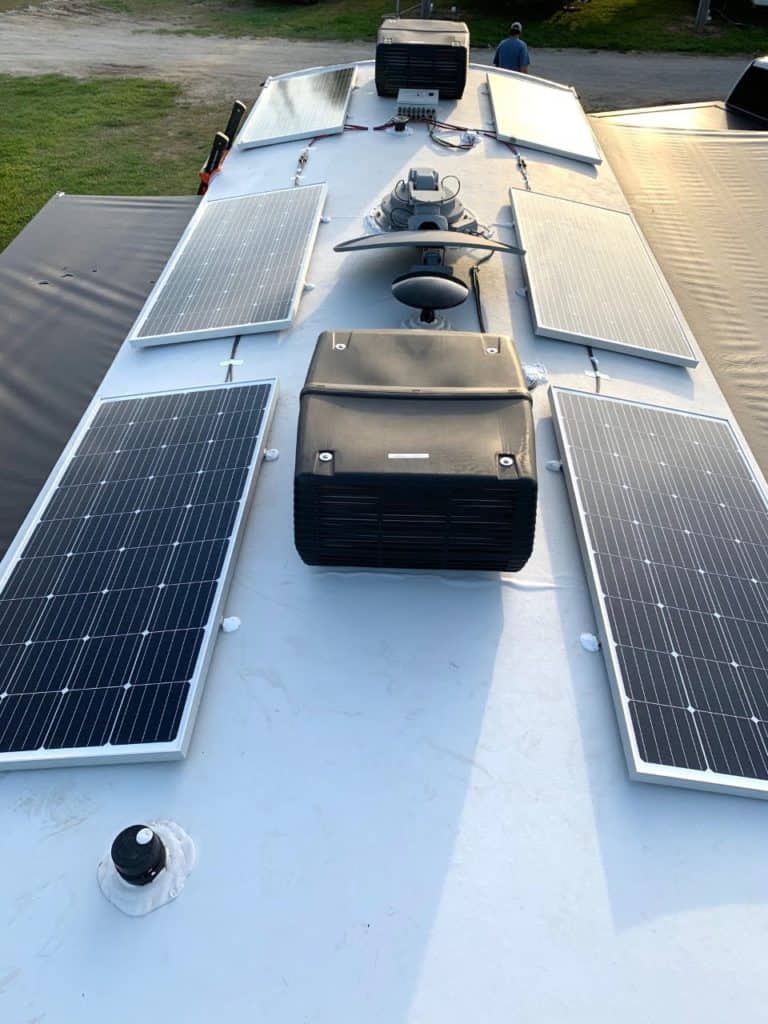Solar Installation Costs Explained for Homeowners
Wiki Article
Discovering the Different Types of Solar Panels and Their Distinct Benefits
The landscape of solar panels offers different choices, each with unique benefits matched to various applications. Monocrystalline panels attract attention for their efficiency and looks, while polycrystalline versions interest budget-conscious customers. Thin-film modern technology gives adaptability in installment. Cutting-edge styles like building-integrated and bifacial photovoltaics better improve the charm of solar power. Comprehending these distinctions is necessary for making educated choices. The inquiry stays: which type will best meet specific power demands?Monocrystalline Solar Panels
Although different sorts of solar panels are available, monocrystalline solar panels are frequently considered one of the most reliable choice. These panels are made from a solitary crystal framework, normally silicon, which enables them to convert sunshine right into electrical power much more effectively than various other kinds. The efficiency prices for monocrystalline panels can range from 15% to over 22%, making them a popular selection for household and industrial setups where room is restricted.
Polycrystalline Solar Panels
Polycrystalline solar panels are produced using an unique manufacturing process that involves melting multiple silicon crystals with each other. This method can result in advantages such as lower production prices, making them a preferred option for lots of consumers. Their efficiency and performance variables might differ compared to various other types of solar panels, calling for cautious consideration.Production Process Advantages
The production procedure of polycrystalline solar panels provides several benefits that add to their charm in the renewable resource industry. The manufacturing utilizes silicon scrap, which decreases waste and lowers material expenses, making it financially feasible. Unlike monocrystalline panels, the manufacturing of polycrystalline panels entails easier and less energy-intensive strategies, causing a smaller carbon impact. In addition, the spreading process enables the development of multiple cells simultaneously, improving efficiency in production. This approach also causes a more consistent framework, which can boost the general efficiency and long life of the panels. Polycrystalline solar panels present a cost-efficient option for customers while promoting sustainable manufacturing practices within the market.Performance and Efficiency Factors
How do effectiveness and efficiency variables affect the efficiency of polycrystalline photovoltaic panels? These panels usually show lower effectiveness prices, balancing around 15-20%, compared to their monocrystalline counterparts. Variables such as temperature sensitivity, shading, and the angle of installation substantially affect their efficiency. Polycrystalline panels often tend to perform better in cooler environments yet might have a hard time in high temperature levels, causing reduced outcome. In addition, their performance can be influenced by dust and debris accumulation, requiring normal upkeep. In spite of these obstacles, polycrystalline panels are extra budget-friendly and use a strong equilibrium in between expense and performance. Comprehending these efficiency and efficiency variables is essential for consumers seeking to optimize solar power manufacturing and total system efficiency.Thin-Film Solar Panels
Thin-film solar panels stand for a lightweight and flexible option in the solar power landscape. These panels are created by transferring one or more slim layers of solar product onto a substratum, which can include plastic, glass, or steel. This production procedure enables for greater adaptability in style and applications compared to standard crystalline photovoltaic panels.
Thin-film technology normally includes lower performance rates, yet it compensates for this with lowered production prices and enhanced performance in low-light conditions. Their light-weight nature makes them suitable for installation on diverse surface areas, consisting of rounded structures and lorries. Additionally, these panels can be integrated right into structure materials, supplying aesthetic benefits along with energy generation.
Bifacial Solar Panels
Bifacial solar panels are acquiring attention for their enhanced performance and performance, as they can capture sunshine from both sides. This dual-sided layout enables boosted power manufacturing, especially in reflective environments. Furthermore, their installation supplies possible expense benefits, making them an appealing option for various applications.Efficiency and Performance
The effectiveness and performance of solar panels are important aspects in establishing their efficiency in energy generation, with bifacial solar panels standing apart for their ingenious design. These panels include solar batteries on both sides, allowing them to capture sunshine from multiple angles. This dual-sided ability boosts energy outcome, especially in settings with reflective surface areas, such as snow or sand. Bifacial solar panels can boost power manufacturing by 10-20% compared to standard monofacial panels. Their capability to harness indirect sunlight adds to their total efficiency, making them an engaging choice for different applications. Developments in innovation continue to boost their efficiency metrics, solidifying their place in the eco-friendly power landscape as an extremely efficient solution for solar power generation.installation and Expense Benefits
When taking into consideration the advantages of bifacial solar panels, the installation procedure and price advantages are substantial elements that can affect decision-making for both household and industrial applications. Bifacial panels can be placed on different frameworks, consisting of rooftops and ground installations, enabling functional implementation. Their capacity to soak up sunlight from both sides boosts power generation without requiring added panels. This effectiveness can bring about decreased overall installation prices, as fewer units may be needed to attain desired power outputs. In addition, their sturdiness frequently converts to lower maintenance expenses over time (Solar Company). As a result, the long-term monetary advantages, combined with installation flexibility, make bifacial solar panels an enticing choice for those looking for lasting energy optionsBuilding-Integrated Photovoltaics (BIPV)
Building-Integrated Photovoltaics (BIPV) stand for a considerable evolution in solar innovation, seamlessly integrating solar batteries into building products click here for more such as home windows, roofs, and facades. This cutting-edge strategy not only generates renewable resource however additionally boosts the aesthetics and functionality of buildings. BIPV systems can replace conventional try this site building materials, decreasing the general expense of building while adding to power efficiency.The combination of solar innovation into building style enables better space application, as these systems can be set up without needing extra land. On top of that, BIPV services are customizable, allowing engineers to develop special designs that complement the building's overall appearance. The dual functionality of BIPV-- offering both as a power generator and an architectural element-- provides considerable advantages in urban environments where room is restricted. As understanding of sustainable structure techniques expands, BIPV is ending up being an increasingly eye-catching alternative for programmers and house owners alike.
Concentrated Photovoltaic (CPV) Systems
Concentrated Photovoltaic (CPV) systems stand for a sophisticated solar technology that mirrors or makes use of lenses to concentrate sunshine onto high-efficiency solar cells. This innovative strategy permits the collection of considerably even more solar power than traditional photovoltaic or pv systems. By focusing sunlight, CPV systems can achieve greater efficiencies, usually going beyond 40%, making them particularly ideal for areas with high straight sunlight.Furthermore, CPV systems generally require much less acreage compared to traditional solar panels, as they produce more power from a smaller footprint. These systems typically incorporate monitoring mechanisms that change the placement of the lenses or mirrors to comply with the sunlight's movement, taking full advantage of power capture throughout the day. CPV innovation is finest matched for particular geographical areas, where straight sunshine is abundant, limiting its applicability in regions with regular cloud cover - Solar Installer. Overall, CPV systems present an appealing alternative for boosting solar energy manufacturing in ideal environments
Comparison of Photovoltaic Panel Effectiveness and Price
Various solar panel technologies exist, their effectiveness and price can significantly differ, influencing consumer selections and market characteristics. One of the most usual kinds-- polycrystalline, thin-film, and monocrystalline-- show distinctive features in efficiency and rates. Monocrystalline panels tend to use the highest efficiency rates, frequently surpassing 20%, yet they usually come with a higher price. In comparison, polycrystalline panels are typically much more budget friendly, with efficiencies around 15-20%, making them a popular selection for budget-conscious customers. Thin-film modern technologies, while much less efficient at about 10-12%, offer versatility and reduced installation expenses, appealing to details applications.Eventually, choosing the ideal solar panel entails evaluating the equilibrium between performance and expense. Customers need to consider their energy requires, budget restraints, and long-lasting savings possibility, as these aspects will determine the best selection for their solar power system.
Often Asked Questions
For How Long Do Solar Panels Usually Last Prior To Needing Substitute?
Solar panels generally last in between 25 to 30 years before requiring replacement. Their toughness depends upon different aspects, including high quality, installment, and regional ecological problems, Continue which can impact their effectiveness and long life over time.
Can Solar Panels Operate In Cloudy or Rainy Conditions?
Solar panels can indeed operate in over cast or stormy conditions, albeit at reduced efficiency. They still record scattered sunlight, permitting power generation, though power outcome may be significantly reduced than on warm days.What Maintenance Is Needed for Solar Panels?
Regular upkeep for solar panels includes periodic cleaning to get rid of dust and debris, checking for damage, guaranteeing connections are safe and secure, and evaluating system efficiency. Routine check-ups can boost effectiveness and prolong the life-span of the panels.Are There Any Ecological Effects From Production Solar Panels?
Yes, producing solar panels can have environmental influences, including source extraction, power consumption, and waste generation. Advancements in innovation aim to lessen these effects, promoting even more sustainable techniques in production and reusing procedures.How Do I Pick the Right Solar Panel for My Home?

Numerous types of solar panels are offered, monocrystalline solar panels are frequently regarded as the most reliable choice. Thin-film solar panels stand for a flexible and lightweight choice in the solar energy landscape. The effectiveness and performance of solar panels are essential variables in determining their performance in power generation, with bifacial solar panels standing out for their ingenious design. Building-Integrated Photovoltaics (BIPV)
Building-Integrated Photovoltaics (BIPV) represent a stand for evolution considerable solar technology, modern technology incorporating perfectly cells into building right into such as roofs, roofings, and facades. Concentrated Photovoltaic (CPV) systems stand for a sophisticated solar technology that uses lenses or mirrors to focus sunlight onto high-efficiency solar cells.
Report this wiki page